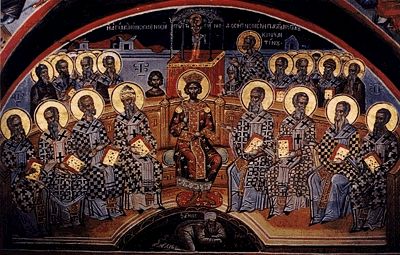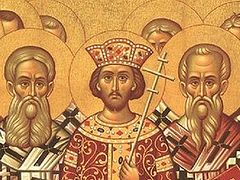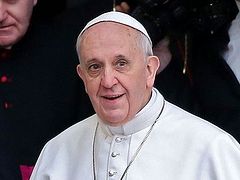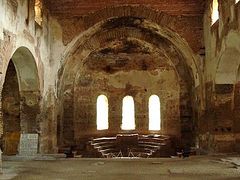Source: Get Religion

The questions jumped into Twitter in a flash, which is what one would assume would happen when there is a chance that a once-a-millennium news story could be breaking.
So Ecumenical Patriarch Bartholomew I and Pope Francis have proposed a 2025 event to mark the great Council of Nicea.
Line up, religion-news consumers, to ask your big questions. Father James Martin, you go first:
Whoa! Huge news. Pope, Patriarch call for Ecumenical Council in 2025. Vatican III? No. Nicea III. East/West together. http://t.co/abrV3rjVse
— James Martin, SJ (@JamesMartinSJ) May 30, 2014
So no Vatican III?
But a proposal for Nicea III?
Slow down. First things first. Was this a proposal for a true Ecumenical Council between the ancient churches of East and West?
It quickly became clear, from Rome and Istanbul, that this was not the case.
FYI #Vatican's Fr Lombardi says Bartholomew's idea for 2025 Nicea is for a common commemoration, NOT an ecumenical council. Tranquilli…
— Nicole Winfield (@nwinfield) May 31, 2014
But what did it mean, really, to say that this date — so far off in the future — is now on the calendar for an ecumenical gathering to celebrate the great Ecumenical Council of Nicea? That, of course, is the gathering of the church fathers best known because of the Nicene Creed and its proclamation of the Holy Trinity.
Once again, I was amazed that the big guns in the mainstream media didn’t jump in on this story. Amazed.
During this week’s Crossroads podcast chat, host Todd Wilken and I pondered, once again, why journalists concluded that the Pope Francis pilgrimage to the Middle East was primarily a political event about statecraft. It was not, repeat NOT, as the Vatican kept stating, an event that grew out of the highly symbolic invitation by Bartholomew for the pope to meet him in Jerusalem. (Click here to listen in.)
In this case, I had written both a GetReligion post (click here) and a Universal Syndicate column (click here) on this topic. In the column I noted:
The symbolic leader of the world’s Eastern Orthodox Christians, the successor to the Apostle Andrew, had earlier invited Francis, the successor to the Apostle Peter, to join him in Jerusalem to mark the 50th anniversary of the breakthrough meeting between Pope Paul VI and Ecumenical Patriarch Athenagoras I. Their embrace ended 900-plus years of mutual excommunication in the wake of the Great Schism of 1054.
So why wasn’t this gathering newsworthy? Why was it missing from the vast majority (kudos to the Associated Press for being a major exception) of the mainstream reports about this trip?
Even in the fine AP report, the truly historic ecumenical prayer rite at the ancient Church of the Holy Sepulcher was referred to as the “spiritual” highlight of the pilgrimage. In the GetReligion post on that I asked:
Ah, there we have it. This was the “spiritual” highlight of the pilgrimage. As opposed to? The political highlight? The real highlight? The news highlight?
Yes, there we have it again, the same old, same old. When the pope travels it is a big news event. Big news is, by definition, primarily about politics. Thus, the most important events in a papal tour must, by their very nature, be political. The religion stuff? That’s nice for photographs, unless the pope stops at an Israeli security wall and there is (validly so in this case) a spectacular photo with political implications.
Got that? Politics are real. Religion is not so real. At best it is “spiritual.”
Now, in the case of yesterday’s bombshell/media blind spot, The Huffington Post did offer a short report that spotted the news hook:
Pope Francis and Ecumenical Patriarch Barthlomew I prayed together in Jerusalem at the Church of the Holy Sepulcher in a beautiful act of unity.
Now, they’re taking a further step to heal the centuries-old schism between the Roman Catholic and Orthodox churches by holding a gathering together to commemorate the Council of Nicaea, which took place in 325. Seventeen centuries later, Francis and Bartholomew will come together in 2025 to celebrate the historic meeting, reports Vatican Insider.
“We agreed to leave as a legacy to ourselves and our successors a gathering in Nicaea in 2025, to celebrate together, after 17 centuries, the first truly ecumenical synod, where the Creed was first promulgated,” Bartholomew told Asia News.
Nicaea, now known as Iznik, brought together over 300 bishops from the Eastern and Western traditions in 325. While the next planned gathering is eleven years away, both leaders can use that time to continue to work towards friendship and cooperation between their churches.
OK, fellow Godbeat scribes, let’s stop and think about this for a moment. This event is a long way off. What else might be on the ecumenical discussion agenda in the meantime?
Obviously, there is the issue of the pope striving to find a way to tweak Rome’s claim for absolute, total primacy over all of the world’s ancient churches, a claim that the other ancient patriarchates cannot accept. However, we have already heard more papal references to the pope being the Bishop of Rome, a title that warms the heart of the Eastern Orthodox. We have also heard papal references to the pope as the patriarch of the West, a title that implies there could still be — as in the first millennium — patriarchs of the East, with the pope seen as the first among equals. And what’s up with the steady drumbeat of “synod” language from Pope Francis?
And wouldn’t it be fitting if, in an event marking the Nicean Council, East and West made progress on the ultimate issue of the 1054 schism, as in the infamous, from an Eastern Orthodox point of view, Roman insertion of the filioque clause into its version of the creed? As Father Alexander Webster, an Orthodox historian, once noted in Crisis Magazine, a conservative Catholic publication:
The real dogmatic difference revolves around the insertion of the Latin compound word filioque into the Niceno-Constantinopolitan Creed originally formulated in Greek by the bishops assembled at the first and second ecumenical councils (325 and 381). The Latin addition has the Holy Spirit “proceed from the Father and the Son” (filioque) instead of proceeding from the Father alone, as in the original Greek. There is no room here to rehearse the arguments for and against that pesky term. Let it suffice to note that the Orthodox are convinced that the insertion radically, albeit unintentionally, changes the meaning of the Creed (by demeaning the Personal dignity of the Holy Spirit) and remain adamant that the filioque must be disavowed by Rome.
And so forth and so on, world without end. Amen.
Yes, Webster’s 2000 essay did propose a way for Rome to end this ancient logjam. Yes, the word “synod” plays a crucial role.




